
Since launching 12 years ago, Bankless Times has brought unbiased news and leading comparison in the crypto & financial markets. Our articles and guides are based on high quality, fact checked research with our readers best interests at heart, and we seek to apply our vigorous journalistic standards to all of our efforts.
BanklessTimes.com is dedicated to helping customers learn more about trading, investing and the future of finance. We accept commission from some of the providers on our site, and this may affect where they are positioned on our lists. This affiliate advertising model allows us to continue providing content to our readers for free. Our reviews are not influenced by this and are impartial. You can find out more about our business model here.
10 Best Crypto Staking Platforms To Use in 2024




Staking has become a popular way to earn passive income—all investors have to do is click a button and then sit back and watch their crypto holdings increase. As well as earning rewards, staking provides an opportunity for anyone to participate in improving the security of blockchains through a process that is considerably more environmentally friendly than mining.
But with so many different platforms offering staking, how do you choose between them? To answer this question, we’ve reviewed and compared all the best staking platforms. We’ll also look at how staking works, the different types of staking, the risks involved, and the best coins to stake.
This comprehensive guide will provide you with all the knowledge you need to make informed decisions about staking and crypto rewards.
- A Quick Look at The Best Crypto Staking Platforms
- 10 Best Crypto Staking Platforms Reviewed
- Comparison of the Best Crypto Staking Platforms
- How Does Crypto Staking Work?
- How To Stake Crypto
- What Are the Best Coins to Stake?
- What Are the Risks of Staking?
- How To Choose The Best Staking Platform
- Final Thoughts
- FAQs
A Quick Look at The Best Crypto Staking Platforms
- Coinbase: Stake your crypto through a reputable exchange for just $1.
- Kraken: One of the most flexible staking platforms to stake over 30 cryptos.
- Uphold: The most beginner-friendly staking platform with weekly payouts.
- Binance: Over 300 cryptos available to stake with flexible lockup periods and weekly payouts.
- Kucoin: The best altcoin staking platform with daily payouts.
- Crypto.com: Earn competitive staking rewards by staking CRO.
- Nexo: Popular crypto staking platform that also offers crypto savings accounts.
- OKX: The best platform to stake Ethereum.
- Ledger: The best cold wallet that offers crypto staking.
- Lido: A reputable staking solution with high liquidity.
10 Best Crypto Staking Platforms Reviewed
Let’s take a closer look at the best crypto staking platforms and their features, pros and cons.
1. Coinbase – Overall Best Crypto Staking Platform
| #️⃣ Coins available for staking or rewards | 7+ |
| 📈 Max rate | 10.69% APY |
| ⚠️ Staking limits | At least $1 |
| ⌛ Pay-out frequency | 1 to 7 days, depending on coin |
| 💼 Type | Flexible |
| 💰 Staking commission | 25% to 35% |
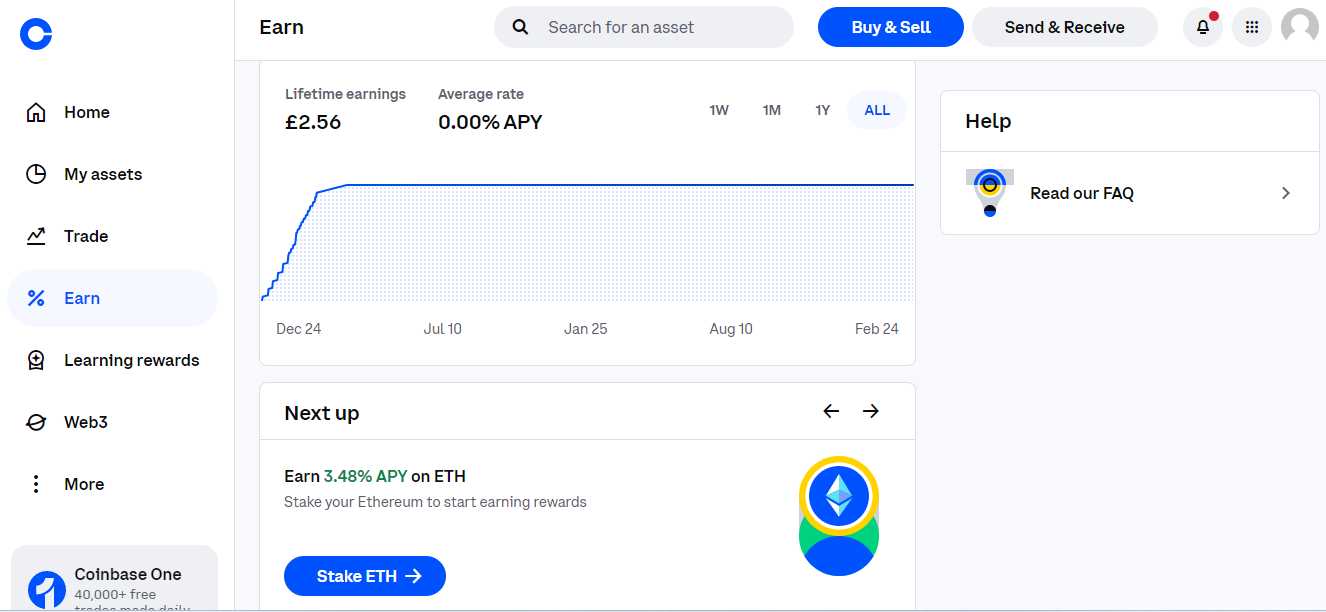
Coinbase is one of the oldest and most popular crypto exchanges. It bills itself as the easiest place to buy and sell cryptocurrency, and this simplicity extends to its staking services, too. You’ll be able to stake crypto tokens in your account with just a couple of clicks.
Coinbase offers flexible staking – there’s no minimum lock-up period and you can unstake whenever you like, though you’ll need to wait for the completion of the token’s unbonding process, plus Coinbase’s additional processing time of up to 48 hours.
The main downsides of Coinbase are the limited selection of staking options and the hefty staking commission of 25% to 35%. But this needs to be balanced against Coinbase’s strong security, transparency, regulatory compliance, broad geographic availability, and the other user-friendly features you’ll get, such as Learning Rewards to Web3 access.
- Easy to use for beginners
- Staking educational resources
- No minimum lock-up period
- Strong security and transparency
- Available almost everywhere
- Limited selection of coins for staking
- High staking commission
2. Kraken – Best For Flexible Staking Periods
| #️⃣ Coins available for staking or rewards | 18+ |
| 📈 Max rate | 24% APY |
| ⚠️ Staking limits | None specified |
| ⌛ Pay-out frequency | Weekly |
| 💼 Type | Flexible or bonded |
| 💰 Staking commission | None (except for ETH) |
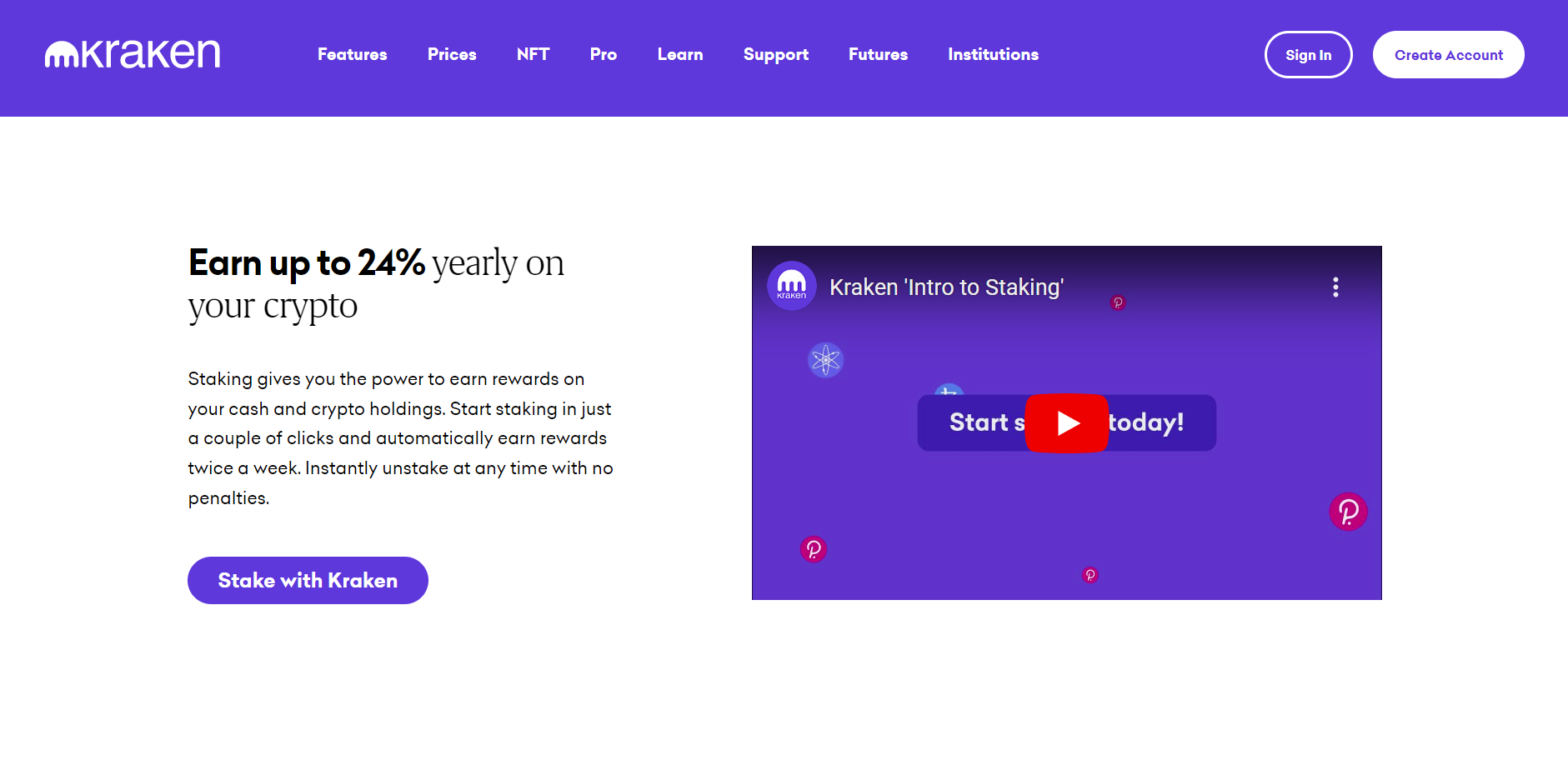


Kraken appeals to both beginners with its simple app and experienced traders with its Pro platform. The staking service is designed to be accessible to everyone, as it only takes three clicks from your balance to stake crypto.
Kraken is a good choice for anyone who values flexibility when staking. You’ll be able to stake instantly without waiting for a bonding period, and if you opt for flexible staking terms, you’ll be able to unstake instantly, with no lock-up or unbonding period.
However, if you don’t mind having to wait after you unstake coins, you can choose bonded staking terms, which provide much higher staking rewards.
As of February 2023, Kraken no longer offers staking to US residents.
- User-friendly
- Higher rewards than many competitors
- Flexible and bonded staking options
- Instant staking and unstaking (Flexible staking)
- Not available in the US
- Ethereum staking not available through the mobile app
3. Uphold – Simplest Way To Stake Crypto
| #️⃣ Coins available for staking or rewards | 32+ |
| 📈 Max rate | 16% APY |
| ⚠️ Staking limits | Vary by coin |
| ⌛ Pay-out frequency | Weekly |
| 💼 Type | Flexible |
| 💰 Staking commission | 3% to 34% |
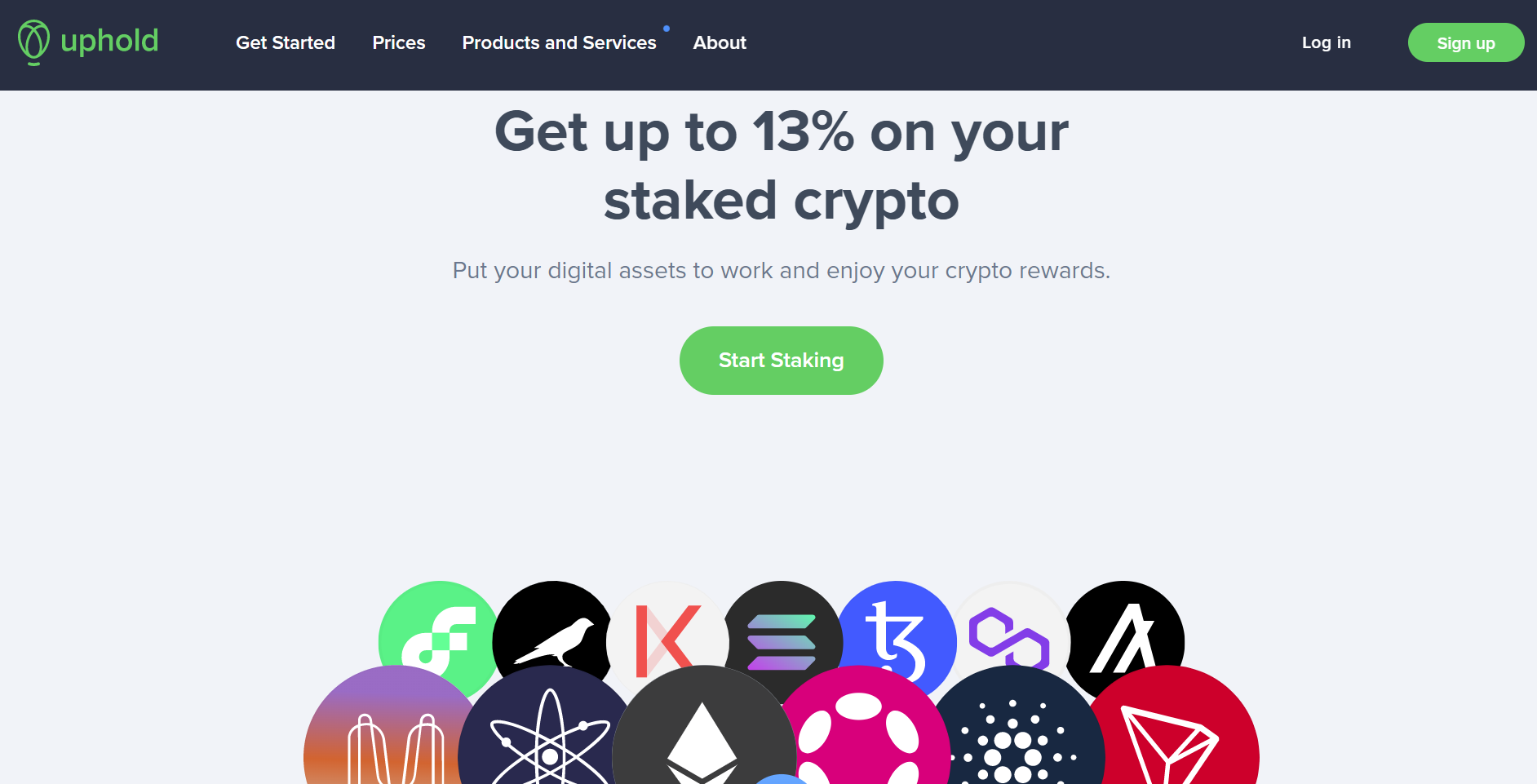


Uphold prides itself on being easy to use and transparent. Users can complete trades in a single click, and the platform is regulated and secure with transparent reserves. All you have to do is select a coin and an amount to stake, and then you can sit back and earn rewards.
The choice of cryptocurrencies available to stake is more extensive than a number of other exchanges, and the rewards rates are pretty competitive. It’s easy to keep track of your earnings as you can view your staking accounts, balances, and rewards-to-date on the portfolio page.
Although some tokens are subject to an unbonding period, Uphold will process unstaking requests much faster when liquidity allows.
- Simple staking process
- Variety of coins available to stake
- Competitive staking rewards
- Easy to track earnings
- Not available in the US
- Weekly maximum unstaking limits for each coin
4. Binance – Best For Choice of Earning Products
| #️⃣ Coins available for staking or rewards | 340+ |
| 📈 Max rate | 36% (principal protected), 540% (high yield) |
| ⚠️ Staking limits | Vary by coin and product |
| ⌛ Pay-out frequency | Every minute for Simple Earn (weekly for Binance.US Staking) |
| 💼 Type | Flexible, fixed-term, DeFi, dual investment, liquid swap, range bound, farming |
| 💰 Staking commission | None |



Although Binance only offers on-chain staking for Ethereum, it provides many other ways to earn rewards. Simple Earn is the safest and easiest option, providing stable earnings on hundreds of tokens with a choice of flexible and fixed terms.
Many of the other earning products provide much higher returns but mean putting your capital at risk. Binance also provides easy access to DeFi staking opportunities for those who want to partake in DeFi activities without navigating dApps.
It’s worth noting that the Binance Earn feature and its wide variety of products aren’t available on Binance.US, but US users can earn up to 12% through on-chain staking of 27+ cryptocurrencies.
- Earn rewards on hundreds of tokens
- Products with different rates, terms and risks
- Rewards automatically compound
- Staking services available in the US
- Very limited on-chain staking outside the US
- Some products are high risk and hard to understand
5. KuCoin – Best For Staking Altcoins
| #️⃣ Coins available for staking or rewards | 100+ |
| 📈 Max rate | 42% (staking), 180% (promotions) |
| ⚠️ Staking limits | Vary by coin and product |
| ⌛ Pay-out frequency | Daily |
| 💼 Type | Staking, savings, dual investment, promotions |
| 💰 Staking commission | None |
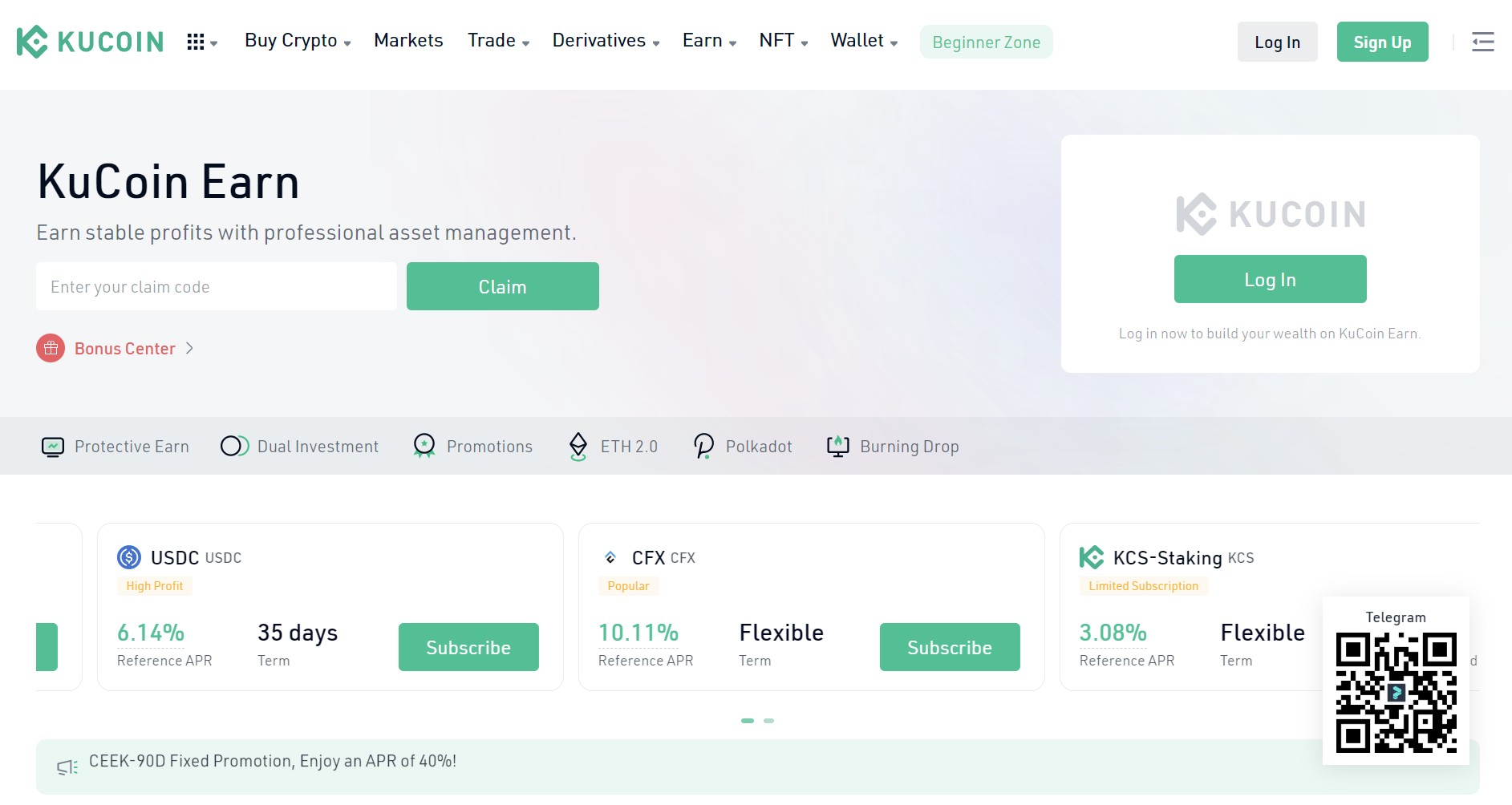


KuCoin describes itself as the number one altcoin exchange, thanks to its selection of over 700 crypto assets, including many that can’t be found on other major exchanges. Many of these obscure altcoins can be used to generate a passive income through KuCoin Earn.
As well as staking, KuCoin offers a number of other earning products, including some that offer higher returns with greater risks. The wide variety of coins and products provides users with plenty of choices.
The reward rates on KuCoin change regularly, and the platform often runs promotions providing higher crypto inerest rates. The main downside of KuCoin is that it isn’t regulated. Also, without completing ID verification, which isn’t possible in the US, you only get access to limited services.
- Huge range of altcoins
- Choice of different earning products
- Regular promotions with higher rewards
- Daily reward payouts
- Not as user-friendly for beginners
- Unregulated
- Limited services in the US
6. Crypto.com – Best Staking Platform For CRO Holders
| #️⃣ Coins available for staking or rewards | 21+ |
| 📈 Max rate | 12.5% |
| ⚠️ Staking limits | Vary by coin |
| ⌛ Pay-out frequency | Weekly |
| 💼 Type | Flexible, 1-month, 3-month |
| 💰 Staking commission | Not specified |
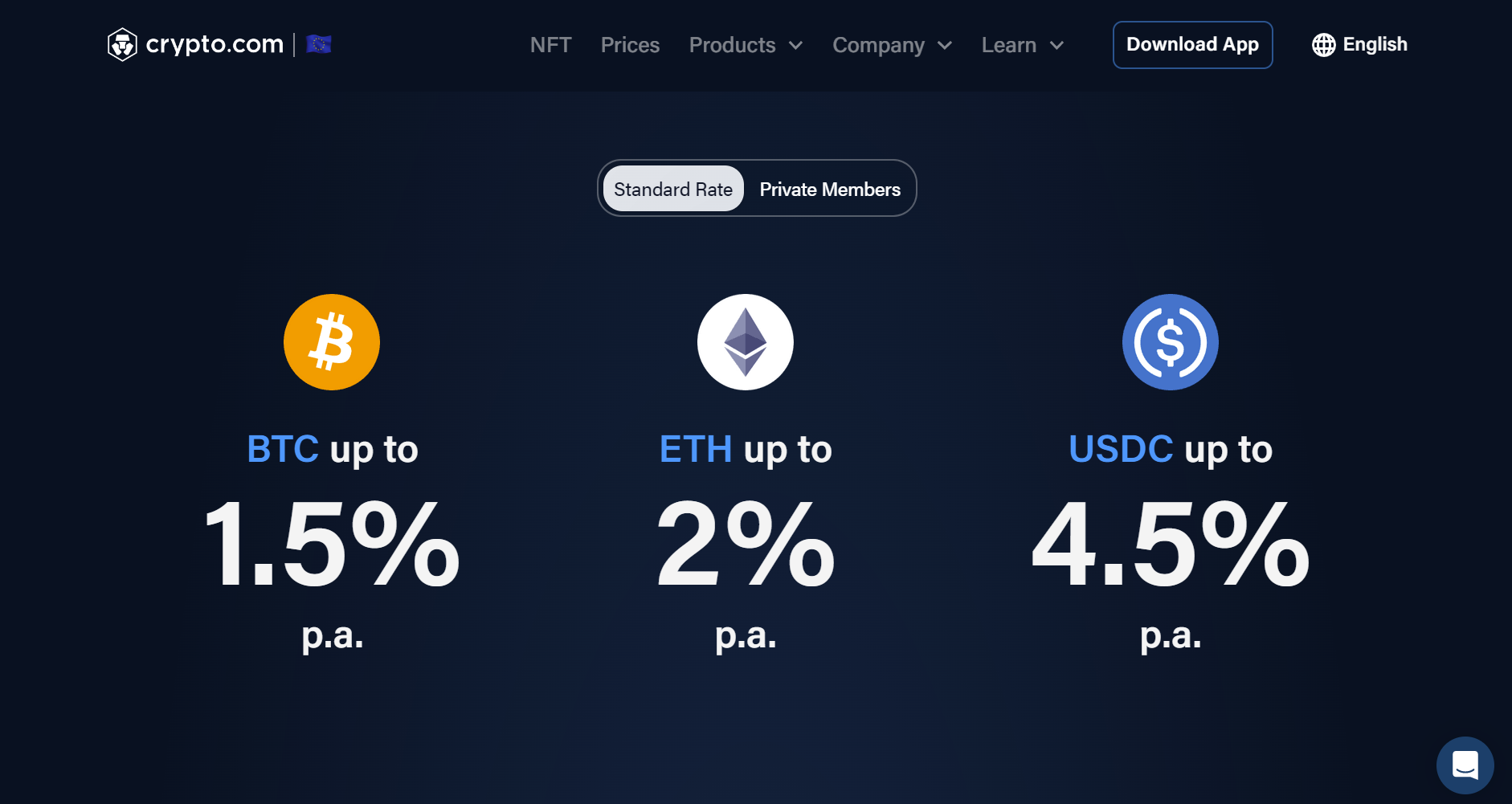


Crypto.com is well-known for its user-friendly app and crypto rewards cards. On top of this, it provides a secure staking service for a good range of cryptocurrencies. Users have the choice between flexible and fixed-term staking.
There is also a Flash Rewards feature that provides a higher rewards rate during promotional campaigns. What’s more, private members get an additional 2% in rewards distributed in Crypto.com’s proprietary CRO tokens.
Unfortunately, the reward rates can be a little difficult to understand. There are different rates for different staking terms, but the rate is also affected by how many CRO tokens you have locked up. Additionally, the tiered rewards structure means only your first $3,000 of staked crypto receives the full rewards rate, while the next $27,000 receives half that rate, and any additional staked coins receive only 30% of the full rewards rate.
Crypto.com, therefore, offers some decent rewards rates to private members and anyone staking less than $3,000 for 3 months with over $4,000 of CRO locked up. However, those staking larger amounts, for shorter terms, or with less CRO locked up will find much better rates elsewhere.
- Secure service
- Higher reward rates for private members and CRO holders
- User-friendly app
- Available almost everywhere
- Complicated rewards structure
- Rates for short-term staking and non-CRO-holders aren’t great
7. Nexo – Best For Crypto Savings Accounts
| #️⃣ Coins available for staking or rewards | 35+ |
| 📈 Max rate | 36% |
| ⚠️ Staking limits | Vary by coin and product |
| ⌛ Pay-out frequency | Daily |
| 💼 Type | Savings accounts (Flexible, 1-month, 3-month, 12-month) |
| 💰 Staking commission | n/a |
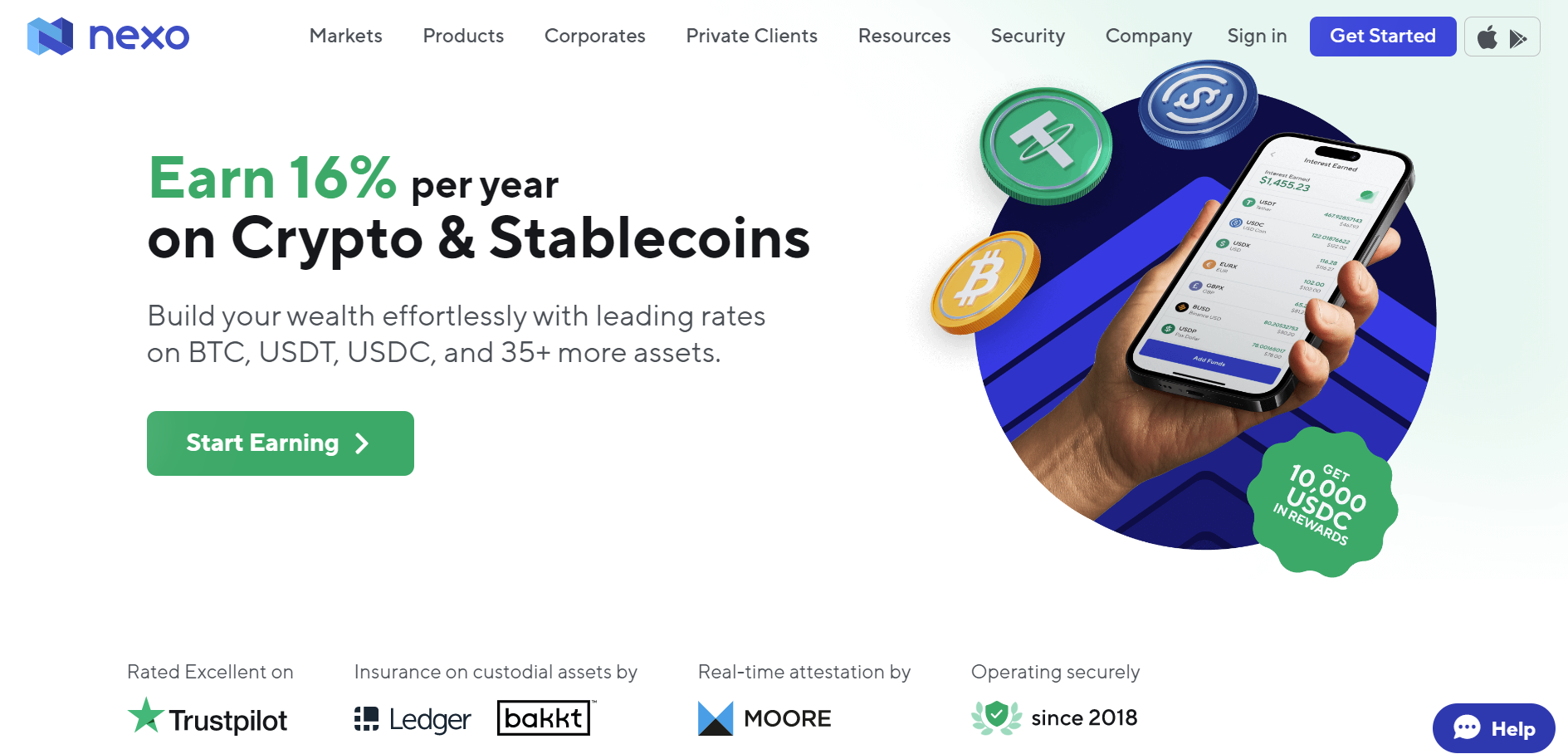


Although Nexo only offers on-chain staking for Ethereum, it provides another way of earning passive income on crypto through its crypto savings accounts. The platform is very easy to use and takes a security-first approach through its collateral requirements, transparency, and custodial insurance.
Nexo offers a choice of savings terms with different crypto interest rates. Rates are also affected by the proportion of NEXO tokens users hold, while choosing to receive interest payments in NEXO can mean an extra 2% in interest.
- Easy to use
- Wide coin selection
- Higher rates than some competitors
- Secure cold storage and insurance
- Lower rates for users without NEXO
- Not available in the US
7. OKX – Best Platform For Ethereum Staking
| #️⃣ Coins available for staking or rewards | 100+ |
| 📈 Max rate | 90% |
| ⚠️ Staking limits | Vary by coin |
| ⌛ Pay-out frequency | Daily |
| 💼 Type | ETH staking, flexible/fixed savings, Shark fin, dual investment, DeFi staking |
| 💰 Staking commission | None |
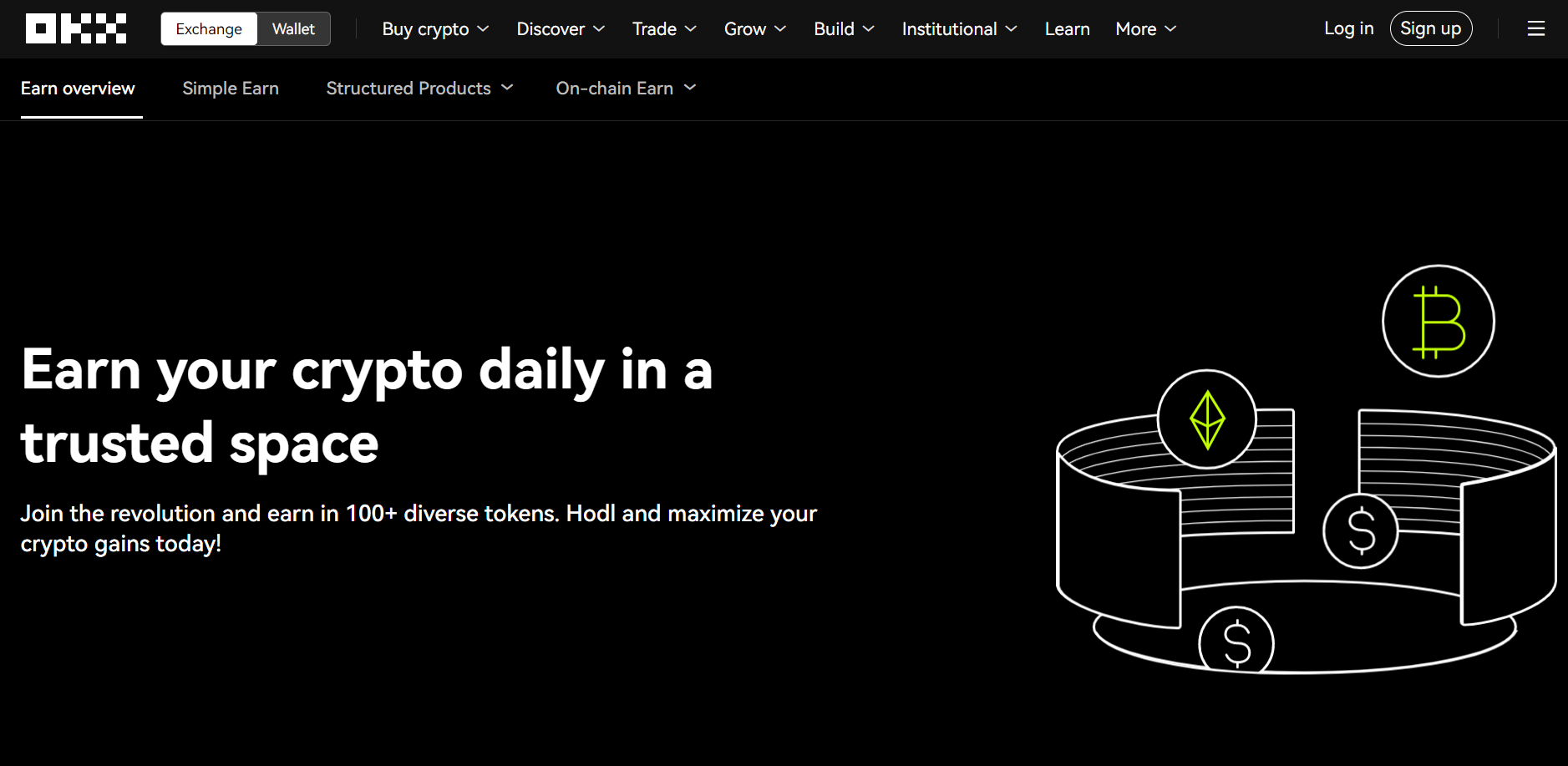


Ethereum is the only coin available for traditional staking on OKX. Users who choose to stake their ETH here will benefit from no staking limits, gas fees, or commission, as well as protection from slashing penalties. What’s more, you’ll receive daily rewards and a staked ETH token that you can trade or sell.
In addition to ETH staking, OKX offers a wide range of Simple Earn products and higher-APY Structured Products, as well as providing easy access to DeFi protocols.
- Slashing penalty protection
- Wide variety of coins and products
- Simplified DeFi staking
- Not available in the US
9. Ledger – Most Secure Way to Stake
| #️⃣ Coins available for staking or rewards | 39+ |
| 📈 Max rate | 25% |
| ⚠️ Staking limits | Vary by coin |
| ⌛ Pay-out frequency | Varies by coin |
| 💼 Type | On-chain staking |
| 💰 Staking commission | Varies by coin |
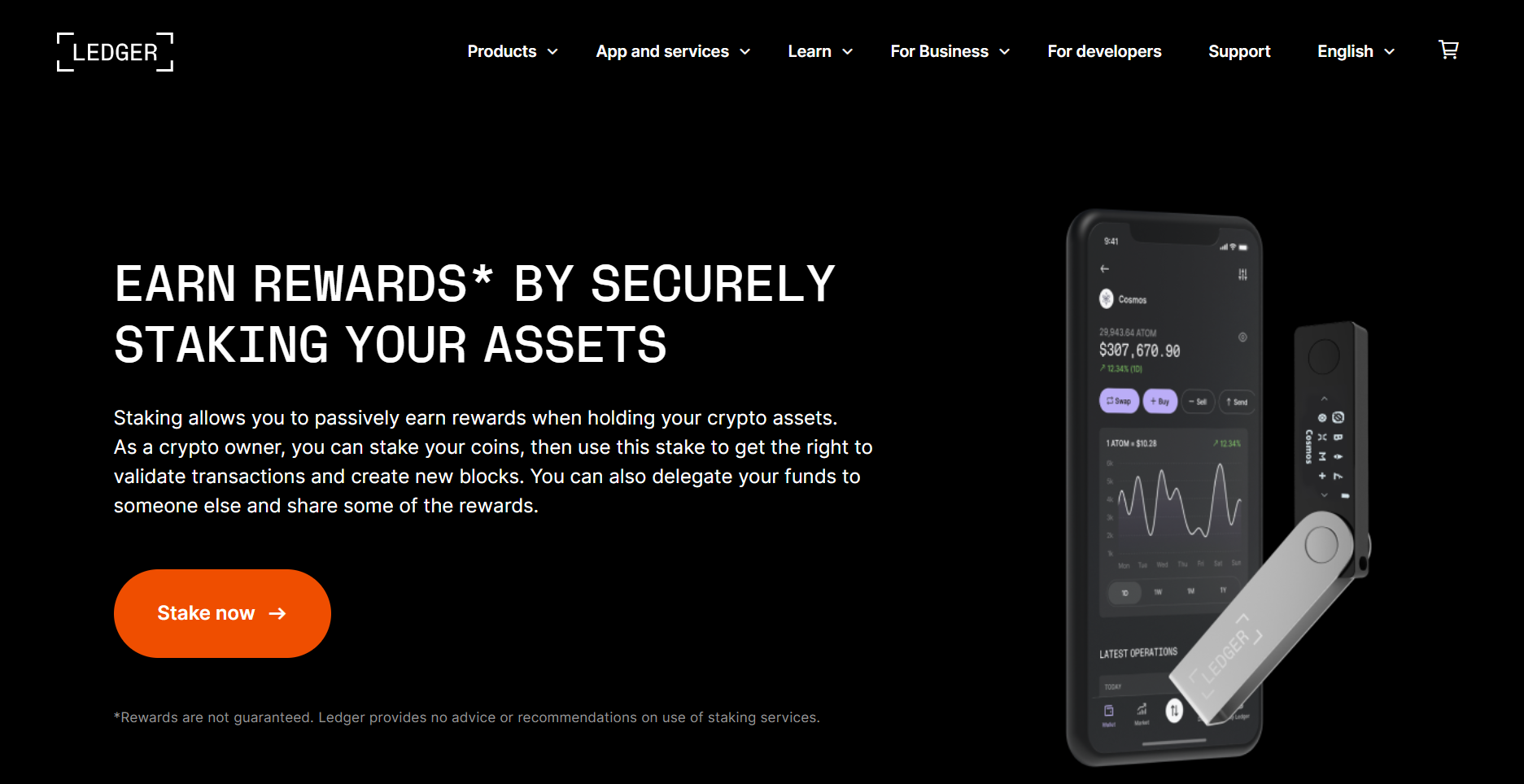


If security is your top priority, then you need a hardware wallet, and Ledger is the best option for staking. Ledger devices are well-known for being highly secure as they store your private keys offline where they can’t be hacked.
Staking with a hardware wallet isn’t quite as easy as using an exchange, as you’ll need to choose your own validators, but this also gives you greater freedom and control over the staking process. You can do all this through the Ledger Live app.
- Highly secure
- Full ownership and control over your assets
- Select the best validators yourself
- Available anywhere
- More complicated than an exchange
- You need to pay for a hardware wallet
10. Lido – Best Liquid Staking Protocol
| #️⃣ Coins available for staking or rewards | 3+ |
| 📈 Max rate | 5.3% |
| ⚠️ Staking limits | None |
| ⌛ Pay-out frequency | Not specified |
| 💼 Type | Liquid staking |
| 💰 Staking commission | 10% |
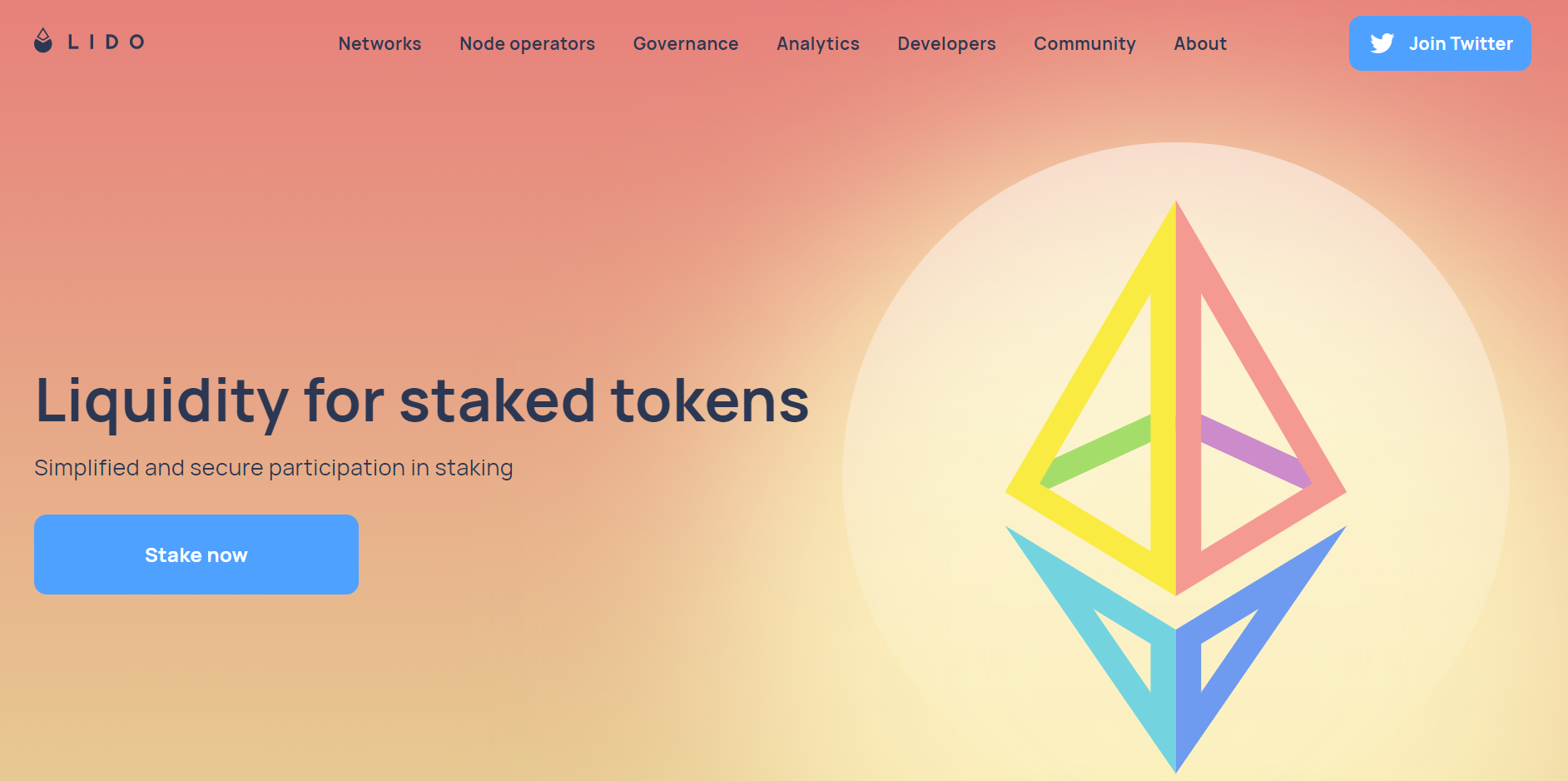


One of the downsides of many staking platforms is that your tokens are locked into the protocol once you stake them, and you may be unable to do anything with them until the end of the lock-up period.
Liquid staking protocols solve this problem by issuing users liquid tokens in return for their staked coins. These liquid tokens can then be used for trading and generating additional yield on DeFi platforms, while your staked coins continue to earn staking rewards.
Although Lido only provides staking for a very limited selection of coins, it is integrated with a wide range of decentralized apps (dApps) to make DeFi participation accessible. Integrated dApps include 1inch, Aave, MetaMask, Curve, Uniswap, and over 100 others.
- Generate additional yield with liquid tokens
- Decentralized security
- Vast range of DeFi integrations
- Accessible platform governance
- Available everywhere
- Only 3 coins available to stake
- May be hard for beginners to understand
Comparison of the Best Crypto Staking Platforms
Here is how the best staking crypto platforms compare on the most important factors.
| Coins available | Max rate | Type | |
| Coinbase | 7+ | 10% | Flexible |
| Kraken | 18+ | 24% | Flexible or bonded |
| Uphold | 32+ | 16% | Flexible |
| Binance | 340+ | 36-540% | Flexible, fixed-term, DeFi, dual investment, liquid swap, range bound, farming |
| KuCoin | 100+ | 42-180% | Staking, savings, dual investment, promotions |
| Crypto.com | 21+ | 12.5% | Flexible, 1-month, 3-month |
| Nexo | 35+ | 36% | Savings accounts (Flexible, 1-month, 3-month, 12-month) |
| OKX | 100+ | 90% | ETH staking, flexible/fixed savings, Shark fin, dual investment, DeFi staking |
| Ledger | 39+ | 25% | On-chain staking |
| Lido | 3+ | 5.3% | Liquid staking |
How Does Crypto Staking Work?
Staking is the process by which Proof of Stake (PoS) blockchains like Ethereum are secured. In order to run smoothly, PoS blockchains require validators who verify transactions on the blockchain. People are incentivized to become validators as they will receive staking rewards in the form of the blockchain’s native token in return.
However, before you’re allowed to validate transactions, you must “stake” a certain amount of your own tokens, ie, lock them up in a smart contract. These staked tokens act like a security deposit. If the validator fails to perform their duties or acts maliciously, their staked tokens can be confiscated in a process known as “slashing”.
Most PoS blockchains allow token holders to get involved in the process without becoming validators. Instead, they can delegate their tokens to one or more validators, who pass on a portion of their staking rewards to their delegators. This provides a way to earn passive income on your crypto holdings without doing any work.
If you stake through a wallet, you’ll need to choose which validator(s) to delegate to, which should involve researching their credentials, like reliability, uptime, and commission. If you use a centralized staking platform, the platform will choose validators on your behalf so all you need to do is click a button.
Flexible vs Locked Staking
Crypto staking platforms may offer flexible staking periods, locked staking, or both.
-
Flexible staking – There is no minimum staking period with this option and you can unstake at any time. Depending on the crypto staking platform, your tokens may be returned immediately when you unstake them, or you may have to wait until the end of an unbonding period.
-
Locked staking – This involves locking up your tokens for a fixed period such as one month. You will probably be unable to access your tokens until the lock-up period ends. On platforms that offer flexible and locked staking, the latter provides higher rewards.
Staking Pools
Staking pools enable multiple token holders to pool their tokens to increase the likelihood of the staking pool operator or validator being chosen to verify transactions, thereby increasing their chances of earning staking rewards. When the minimum stake to become a validator is high, staking pools enable those with lower amounts to get involved.
Liquid Staking
Although you can’t access staked coins while they’re staked, protocols like Lido provide you with liquid tokens in return. For example, if you stake some ETH, you will be given stETH in return, which is a token that represents the value of your staked ETH. You can then sell your stETH at any time, trade it, or use it to generate yield on DeFi platforms.
DeFi Staking
DeFi staking can refer to participating in the PoS process through a decentralized protocol, rather than through a centralized platform.
The term DeFi staking is also sometimes used to refer to other methods of locking up tokens to generate returns on decentralized finance platforms. This could include lending or liquidity mining, which means depositing tokens into the liquidity pools of a decentralized exchange (DEX) to help it facilitate trades and earn yourself trading fees.
Other Earning Products
Some platforms offer other ways to earn rewards on crypto assets as well as or instead of staking. Although these products don’t involve participating in a PoS process, the term “staking” may sometimes be used to refer to them.
These products could include crypto lending or crypto savings accounts, which typically generate returns on your crypto by lending it out to borrowers or margin traders. You may also be offered riskier higher-yield products such as dual investment.
How To Stake Crypto
These steps illustrate how to stake ETH on Coinbase, but the process is pretty similar for other coins and platforms. Before you can get started, you’ll need to sign up to Coinbase and buy or transfer some ETH.
What Are the Best Coins to Stake?
Which are the best coins to stake could depend on a variety of factors and ultimately comes down to your personal priorities. Here are some of the things to consider when choosing which coins to stake.
Staking rewards – The reward rate differs from coin to coin. Some may provide returns of 2% per year and others 25%. It’s natural to want to stake the coin with the highest rewards, but you should balance this against the other considerations below. Also, bear in mind that most reward rates are dynamic so will change over time.
Lock-up period – Some coins need to be staked for a minimum period, and once you unstake them, you may need to wait through an “unbonding” period before you regain access. This amount of time can vary from seconds to weeks, so it’s worth finding out what the unbonding period is for coins you’re thinking of staking.
Penalties – Some blockchains penalize inadequate validators by “slashing” (confiscating) their staked coins, and for some of those blockchains, those penalties could be passed onto the delegators. Check whether the coins you want to stake implement any penalties.
Tokenomics – This means the economic design of a token and its staking process. Some blockchains generate staking rewards through inflation, some through fees, and some through a combination. What’s more, the staking rewards rate may be designed to change with the total amount staked or to increase/decrease over time.
Fundamental value – This is the intrinsic value of a coin based on a variety of factors such as its development team, security, adoption, use cases, and competitors. A coin with strong fundamental value is less likely to fall in price during long-term staking.
Availability – Not all coins are supported by all staking platforms. If there is a particular staking platform you want to use, you will be limited to which coins are available for staking on it.
Bearing all these things in mind, here are some of the best coins to stake in 2024.
| Coin | Annual Reward Rate* | How To Stake |
| Ethereum (ETH) | 5.4% | Ethereum Staking |
| Cardano (ADA) | 4.6% | Cardano Staking |
| Binance Coin (BNB) | 2.5% | BNB Staking |
| Solana (SOL) | 6.4% | Solana Staking |
| Polkadot (DOT) | 15.8% | Polkadot Staking |
| Cosmos (ATOM) | 9.7% | Cosmos Staking |
| Algorand (ALGO) | 8.1% | Algorand Staking |
| Chainlink (LINK) | 5.0% | Chainlink Staking |
*Rewards rates are subject to change and will vary by staking method and platform
What Are the Risks of Staking?
Although staking brings rewards, it’s not without risks as well. Here are some of the things you should be aware of before deciding whether to stake.
Slashing – This is when a validator has some or all of their staked tokens confiscated for failure or acting maliciously. On some blockchains, their delegators may also be slashed. Thankfully, this doesn’t happen very often on most blockchains. Also, some staking platforms commit to protecting their users from slashing penalties.
Lack of access to staked tokens – Your tokens can’t be sold or traded while they’re staked (unless you receive liquid tokens). You may also need to wait through an unbonding period before you can unstake them. This means staking may not be suitable if you want to be able to sell at short notice.
Counterparty risk – When you stake through a platform, you will be trusting that platform to take care of your digital assets. DeFi protocols could potentially contain bugs that could leave them vulnerable, while CeFi platforms could potentially get hacked, go bankrupt, or terminate staking due to regulatory sanctions.
Volatility – Cryptocurrency prices are known for being highly volatile. Even if you generate good returns in a certain token, the price of that token could crash and leave you with a significantly less valuable investment.
Tax implications – In many countries, staking rewards are subject to income tax, and you may also need to pay capital gains tax when you sell them. Many staking platforms report to the IRS so you’ll need to pay your tax obligations to avoid penalties. What’s more, receiving liquid tokens when you stake may be considered a disposal and trigger a taxable event.
How To Choose The Best Staking Platform
So, you’ve decided you want to stake your coins, but how do you choose between the many staking crypto platforms available? Here are some of the main factors to consider.
Staking reward rates – The crypto staking rewards offered by different platforms can vary greatly. As well as comparing rates, it’s worth looking at whether crypto staking platforms offer compound interest. An annual percentage yield (APY) will provide more returns in the long run than a flat annual percentage rate (APR).
Staking coins supported – The variety of crypto staking coins available will differ on different staking platforms. Some offer loads and other staking platforms hardly any. Check whether the coins you want to stake are supported.
Staking fees – Some crypto staking platforms take a staking fee by keeping a proportion of the staking rewards for themselves. The amount they take in staking fees can impact the rate of rewards you receive.
Types of staking – Staking platforms may offer flexible staking or fixed-term staking, as well as other earning products like savings accounts. If you want to be able to access your staked crypto assets easily, you should look for a platform that lets you unstake instantly with no minimum staking period.
Ease of use – Some platforms are more user-friendly than others. This is particularly important for beginners, as you’re less likely to make a mistake on a platform that is easy to use and provides helpful guidance.
Other features – If you want to be able to sell, swap, or trade your coins as soon as you unstake them, you’re better off staking through a crypto exchange with good trading tools than a wallet without them. Other features that may be available include lending, NFT support, and educational resources.
Security – The best staking platforms are highly secure and protect you from theft and hacks when you’re staking cryptocurrency. Security features to look for include 2FA, address whitelisting, cold storage, and insurance.
Regulation and availability – Clearly, crypto platforms are only of use to you if they’re available where you live. On top of this, crypto investors should look into the regulatory status of a platform, as regulated staking platforms are generally safer. If a platform isn’t licensed to operate in your country, it could receive a regulatory warning and cease operating there.
Final Thoughts
Staking is increasingly popular with crypto investors as it provides an easy way to earn interest on idle crypto assets. Many platforms enable users to begin staking at the click of a button, and there are lots of different crypto staking platforms to choose from.
Coinbase supports staking for some of the most popular crypto assets. It is our top pick due to how secure and easy to use it is, as well as the range of other innovative features it provides, such as learning rewards and Web3 access.
FAQs
Which exchange has the highest staking rewards?
Binance offers some of the highest returns through its higher-risk high-yield earning products. But in terms of on-chain staking, Kraken’s bonded staking is one of the best ways to earn interest.
Are staking rewards taxed?
Staking rewards are taxed in most countries. You will likely pay income tax on rewards you receive, as well as capital gains tax when you dispose of your rewards.
Can you lose money staking crypto?
Although rare, it is possible you could lose some or all of your stake through slashing or a hack. It is also possible that the monetary value of your tokens could decrease while they’re staked, so you could realize a loss when you sell even if you have more tokens.
What is the best staking wallet?
If you want to stake from a wallet, a hardware wallet like Ledger is the most secure option. If you want to use a free software wallet, Atomic Wallet provides a user-friendly way to stake more than 20 coins.
Is staking crypto profitable?
This depends on the coin, staking rewards rate, and market conditions. Staking provides you with returns in the form of cryptocurrency, but whether you make a fiat profit will depend on the prices of your staked coins at the point of purchase and sale.
Are there fees for crypto staking?
If you delegate to a validator, they will keep a proportion of the staking rewards your coins receive as a commission for their service. If you stake through a platform, the validator’s commission will still be deducted, and the platform may take its own commission as well. Also, there may be a gas fee for staking and unstaking on some blockchains.
Contributors




